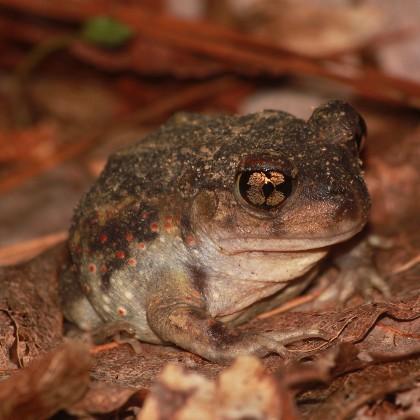CORVALLIS, Ore. – Research by a graduate student in Oregon State University’s College of Science has upended the conventional wisdom that for a century has incorrectly guided the study of a toad listed as endangered in part of its range.
Anne Devan-Song used spotlighting – shining a light in a dark spot and looking for eye reflections – to find large numbers of the eastern spadefoot toad. The study illustrates how confirmation bias – a tendency to interpret new information as ratification of existing theories – can hamper discovery and the development of better ones.
Her findings, which show that the toad spends much more time above ground than commonly believed, were published in the Journal of Herpetology.
Known for bright yellow eyes with elliptical pupils and, as the name suggests, a spade on each hind foot, the eastern spadefoot toad ranges from the southeast corner of the United States up the Atlantic Coast to New England. Known scientifically as Scaphiopus holbrooki, it is a species of conservation concern in the northern reaches of its territory.
Devan-Song, a Ph.D. student in integrative biology, grew up in Singapore, where she learned she could search for reptiles and amphibians by spotlighting. In Rhode Island, where she earned a master’s degree and then worked as a university research associate, the eastern spadefoot toad is endangered.
One rainless night while surveying for amphibians during a project in Virginia, Devan-Song’s spotlight detected one eastern spadefoot after another. That surprised her because the toads were thought to be detectable only on a few rainy nights every year, when they emerge from underground burrows to mate in wetlands.
She continued looking for eastern spadefoots and kept finding them on dry nights, including in upland forest locales not close to any damp areas. Spadefoots remain still when spotlighted so it was easy for Devan-Song to approach the eye-shines and positively identify the toads.
“They need to get above ground to hunt for insects and build up energy stores for mating,” she said. “That’s why we were finding them when and where conventional wisdom said we weren’t supposed to be finding them.”
Back in Rhode Island, she tried spotlighting for spadefoots; it took her just 15 minutes to find one. The success led to a 10-night survey in a pair of locations last summer that produced 42 sightings – nearly double the number of eastern spadefoot toad sightings in Rhode Island over the previous seven decades.
Devan-Song also learned that she wasn’t the first to question the notion that the eastern spadefoot was so “secretive” as to almost always avoid detection. As far back as 1944, Devan-Song said, it was suggested in scientific literature that the toad could be found outside of rain-induced migration and breeding aggregations. And in 1955, researchers used spotlighting to detect huge numbers of eastern spadefoots in Florida; the technique subsequently, inexplicably fell into disuse.
“Confirmation bias perpetuated the fallacy of when the eastern spadefoot could be found,” Devan-Song said. “No breeding events or migration occurred during our surveys and we detected thousands of toads in Virginia and dozens in Rhode Island. The majority of those were subadults, a demographic category mainly overlooked in the literature. Progress in learning about the toad, its ecology and its conservation has been greatly hindered by a misconception that persisted even when evidence to the contrary was presented.”
The ease with which many toads could be found during breeding, combined with a lack of data on toads in upland habitats, helped fuel confirmation bias in this case, she said.
“Everyone assumed they were underground most of the time so no one was really looking for them most of the time,” Devan-Song said. “Our research demonstrates that you can detect them year round, though they do remain rare in Rhode Island. But likely not as rare as the scientific community thought.”
###
The National Park Service, through a cooperative agreement with the University of Rhode Island, supported this research.
Media Contact
Anne Devan-Song
[email protected]
Original Source
https:/
Related Journal Article
http://dx.





